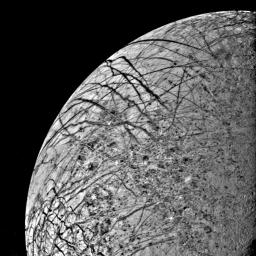Europa Linear Features from 246,000 kilometers
Caption:
The first close look ever obtained of Jupiter's satellite, Europa, was taken today, July 9, by Voyager 2 as the spacecraft approached the planet. The linear crack-like features had been seen from a much greater distance last March by Voyager 1. This picture was made at a range of 246,000 kilometers (152,000 miles) and provides a resolution of about four kilometers (2.5 miles). The complicated linear features appear even more like cracks or huge fractures in these images. Also seen are somewhat darker mottled regions which appear to have a slightly pitted appearance, perhaps due to small scale craters. No large craters (more than five kilometers in diameter) are easily identifiable in the Europa photographs to date, suggesting that this satellite has a young surface relative to Ganymede and Callisto, although not perhaps as young as Io's. Various models for Europa's structure will be tested during analysis of these images, including the possibility that the surface is a thin ice crust overlying water or softer ice and that the fracture systems seen are breaks in that crust. Resurfacing mechanisms such as production of fresh ice or snow along the cracks and cold glacier-like flows are being considered as possibilities for removing evidence of impact events. Europa thus appears to truly be a satellite with many properties intermediate between Ganymede and Io.
Cataloging Keywords:
| Name |
Value |
Additional Values |
| Target |
Europa |
Callisto, Ganymede, Io |
| System |
Jupiter |
|
| Target Type |
Satellite |
|
| Mission |
Voyager |
|
| Instrument Host |
Cassini Orbiter |
Voyager 2 |
| Host Type |
Orbiter |
Flyby Spacecraft |
| Instrument |
Imaging Science Subsystem (ISS) |
|
| Detector |
|
|
| Extra Keywords |
Crater, Grayscale, Impact, Water |
| Acquisition Date |
|
| Release Date |
1999-03-23 |
| Date in Caption |
|
|
| Image Credit |
NASA/JPL |
| Source |
photojournal.jpl.nasa.gov/catalog/PIA01523 |
| Identifier |
PIA01523 |

